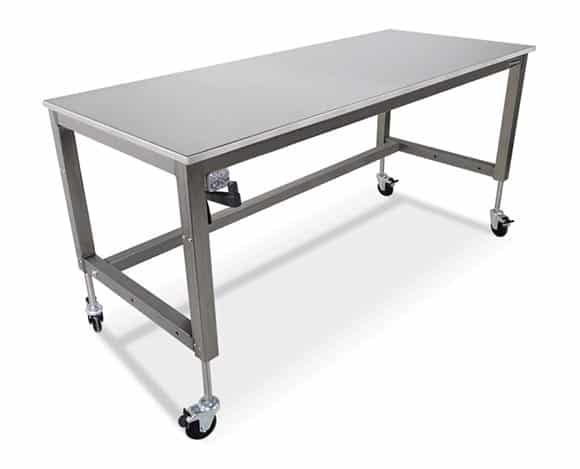When it comes to understanding how to manage a museum effectively, it’s helpful to learn more about the roles of five departments that make up the backbone of museum operations. They are (1) the Conservation Department, (2) the Documentation Department, (3) the Research Department, (4) the Exhibition Department and (5) the Educational and Information Services Departments.
In this article, we will look at each of these five museum departments in detail.
1. The Conservation Department
The Conservation Department plays an important role in research and protecting museum artifacts. Museum curators and conservators rely on a combination of skills and techniques that, depending on the project, combine the patient, observational work of a crime investigator, the methodical approach of a research scientist, and the deft hand of an artist at working in an art studio setting.
The following video from the National Portrait Gallery, London, featuring conservator Nicole Ryder, helps us get a sense of the day-to-day activities of a professional conservator.
Ryder takes us through the key steps of caring for the museum’s collection of paintings — from the investigation stage that relies on careful observational skills (assisted by a microscope) to the restoration stage which requires the skills of an artist to remove and repair the painted surface (oftentimes removing ill-considered restoration work performed decades or even centuries earlier.)
Common Design Elements for Museum Conservation Laboratories
Like other laboratory projects, each museum’s conservation laboratory is different. But from our experience in creating conservation laboratory environments for major museums, there are some elements that are common to most installations. These include:
- Workbenches
It’s important to specify custom designed workbenches with ergonomic features, such as height-adjustable work surfaces, to provide a comfortable yet sturdy work environment for museum conservators and technicians. Formaspace offers heavy-duty tables capable of supporting 1,000 pounds (or more if needed when you order extra heavy duty workbenches or tables.)
- Specialized Equipment Tables
Expensive conservation lab equipment needs a solid foundation. Formaspace custom designed tables can protect your investment, while providing special features, such as vibration isolation, for lab processes that are sensitive to vibration.
- Chemically Resistant Countertops
When choosing countertop materials for conservation labs, keep in mind the potential for inadvertent chemical spills. Common options include stainless steel or chemically resistant phenolic and epoxy resin countertops. Formaspace Design Consultants can help you specify the most appropriate choice for your needs.
- Snorkels and Fume Hoods
It’s critical to protect conservators and lab technicians from harmful chemical fumes or exposure to damaging particulates that can be released during conservation activities. Overhead snorkels or fume hoods draw fumes and particulate matter up and away from the workspace.
- Flexible Mobility Solutions
When it comes time to move irreplaceable museum artifacts or costly laboratory testing gear, choose rugged mobile carts and tables from Formaspace. We make strong, durable custom-designed mobile furniture that will help you move precious cargo safely and securely.

To illustrate these features in the real world, here is a photo of a recent Formaspace laboratory project installation at the Denver Museum of Nature & Science’s Artifact Maintenance and Protection Lab. Each of the Formaspace Basix (TM) benches can support 1,000-pound loads and are kitted out with countertops made from chemically resistant phenolic and epoxy resin. Built-in overhead fume snorkels remove harmful chemicals and particulate that may be released during conservation activities. To learn more, contact your friendly Formaspace Design Consultant for details. (Formaspace is a GSA scheduled supplier.)
2. The Documentation Department
Conserving and displaying art and artifacts is just one aspect of a typical museum’s mission. There is also a need to create and maintain supporting documentation for each item in the museum’s collection. This is typically the responsibility of the Documentation Department.
This collected data is used in multiple ways. Inventory control is one example. Museum documents are also typically made available to scholarly researchers within the institution or to external museums or educational institutions. Museum interpreters also turn to the available documentation when they develop a plan to present the museum’s collection to the public in an interesting, educational manner.
An exciting development in recent years is the direct sharing of museum documents and records directly with the public over the Internet.
The award-winning History of Vaccines website, created by the Mutter Museum in Philadelphia is an excellent example of information from the documentation department being shared directly with the public. We’re likely to see more of this type of online access to museum documentation as augmented/virtual reality becomes more mainstream.
3. The Research Department
When conservators and museum curators need more information they turn to the museum’s Research Department. At the top institutions, it’s not surprising to find museum research departments with advanced scientific capabilities, ranging from X-ray painting analysis, DNA testing, carbon dating capabilities, as well as high-power gear for microscopic, chromatographic, and spectrophotometric analysis. Indeed, many of today’s top museum research departments rival the capabilities of leading commercial and educational institution research labs.
In the video from the British Museum in London above, liquid chromatography-mass spectrometry is used to uncover the dyeing process used to add color to the fragile fibers of an embroidery dating back to the Tang dynasty (618-907 CE)
If this type of scientific research has piqued your interest, we recommend perusing the key findings of the National Gallery of Art (NGA), which has documented hands-on case studies of chemical imaging investigations of the works from major artists, ranging from Rembrandt to Degas to Jackson Pollock.
4. Exhibition Department
In the Exhibition Department, museum exhibit designers and technicians work closely with the museum’s curators and interpreters to create the inspirational design elements and display mounts that discreetly (but securely) hold the artworks and artifacts safely from harm’s way.
Many of the Exhibition Departments at major museums have a workshop facility dedicated to mounting exhibitions. (This is typically separate from the conservation lab.)
These workshops provide space for museum technicians to construct a wide range of crates and containers to safely pack art and artifacts into storage — or prepare them for shipping to other museums when the items are loaned out.
Conservator Zahira Veliz steps us through the slow, painstaking process of mounting an exhibition with priceless works art from the Prado Museum. Note the careful process of unpacking and hanging the paintings; all the work surfaces are thickly padded to protect the art.
5. Educational and Information Services Departments
The mission of many museums includes providing educational programs for schools. These activities, which are typically managed by a dedicated Educational department within the institution typically include:
- Providing educational support materials for teachers, such as teaching plans or structured activity guidelines
- Hosting school tours through the museum’s collection or a dedicated hands-on learning environment
- Sending traveling exhibitions or loan materials to school campuses

Formaspace created the furniture for the hands-on learning/activity zone at the Arizona Science Center in Phoenix. It’s popular space that’s designed to help young visitors learn to make their own scientific discoveries.
In addition to providing educational outreach, many museum institutions have a dedicated Information Services department whose mission is to provide information to scholars and the public.
Information Services departments can offer a variety of services; some common examples include:
- Publication of printed books, guides, catalogs, and magazines that support the museum’s educational mission.
- Providing the public or scholars with access to museum archivists and historians who can assist with research activities.
- Access to the museum’s research library for select members of the public or scholar community that need to examine museum documents and artifacts up close.
Learn More about Museum Career Opportunities
We hope you’ve enjoyed our overview of the five core concepts to operate a museum.
If you are interested in pursuing a museum career, look for educational opportunities (including accredited 4 year programs) listed with major museum organizations, such as the International Institute for Conservation of Historic and Artistic Works (known as the IIC) and the American Institute for Conservation of Historic & Artistic Works (AIC).
Formaspace Can Help Your Museum Grow

We’re here to help.
Whether you are building a new museum or embarking on an important renovation or expansion, you can turn to Formaspace for furniture solutions for your conservation lab, exhibition workshop, mobile exhibition displays, hands-on exhibits, onsite cafe or restaurant, as well as museum lobbies and reception areas.
Give our friendly Formaspace Design Consultants a call at 1-800-251-1505.
They’ll be happy to talk to you about our portfolio of museum design projects, our concepts for modern space planning and furniture installations as well as the custom furniture manufacturing capabilities we offer out of our Austin, Texas factory headquarters.













